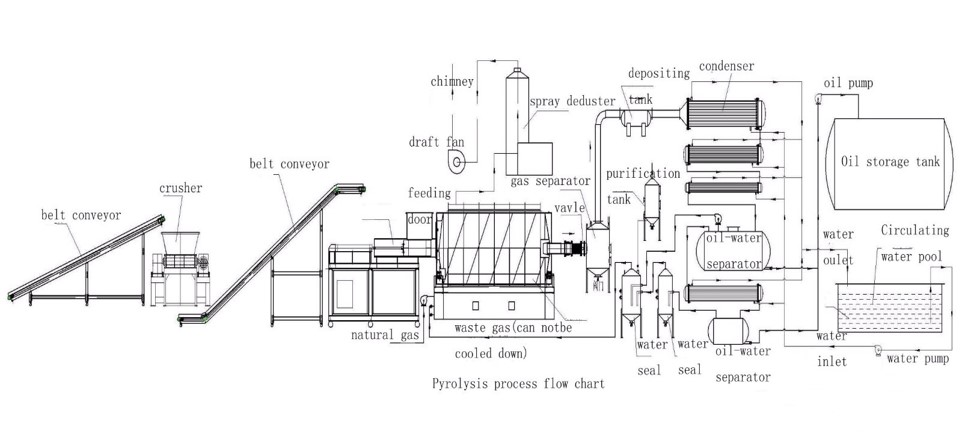Our solution to the waste problem is
#WasteToValue

AmoCarbon, in cooperation with internationally competent partners, has developed the #WasteToValue technology concept, and provides the so-called CARO (Continuous Anaerobic ReOiling) technology. With this concept the serious disposal problems can be solved ecologically and profitably:
- Processing of non-recyclable plastics from household waste into high-grade fuel
- Processing of plastics from rivers and the seas into fuel, that can be used in the ship’s own engine
- Utilisation of non-recyclable industrial polymer waste
- Processing of polymers/drugs from the medical industry that would otherwise need special waste disposal
- Processing of PET-residues in PET-recycling-plants into electricity and process heat, making the plant more ecologically and economically viable.
- Processing of different waste materials like tires, electrical and cable scraps, textile and carpet scraps, waste oil, paint and lacquer leftovers, waste from animal husbandry, sludge and others into high-grade Carbohydrates
- Processing of oil-sludge and oil-water-mixtures especially on ships into fuel
- And many more applications
This is how the #WasteToValue process- and system-concept works
Today household waste is mostly composed of five Fractions:
1. Metals: The different metals are easy to separate from the waste and can be sold easily at metal smelters.
2. Glass: The so-called cullet is also easily separable and is a required product by the glass industry for production of glass.
3. Paper / Cardboard: the paper cardboard mixtures too are readily processed in many different well-established processes to create a wide variety of products.
Whilst separation and processing of these three fractions is already standard practice, together with our consortium of specialised companies we have the most innovative state of the art solutions at our disposal.
So far there have been no or only insufficient concepts for processing the 4th and 5th fraction. For these two fractions, AmoCarbon has innovative technologies that literally turn waste into value.
4. Organic waste: This problematic mixture of partly contaminated organic materials is now rotting with strong odor and gas creation in landfills and often threatens groundwater sources. AmoCarbon has a process available in which this mixture, under exclusion of air, is converted into a high-quality organic fertilizer by so-called effective microorganisms. During this process organic toxins and pharmaceutical contaminants are completely broken down. In conjunction with the activated carbon generated in process no. 5, an AmoCarbon organic fertilizer with extraordinary characteristics is created, for which there is large global demand.
5. Mixed plastics: This mixture of contaminated plastics of all kinds is the biggest problem in waste processing. Up to now for this fraction there was no satisfactory solution for a sustainable recycling.
Our concept - the best solution to the problem of plastic mixtures
With the combination of the CARO-process (Continuous Anaerobic ReOiling) and the Hydrofuel-process, AmoCarbon now has a technology at its disposal that profitably solve this major problem of waste processing.
The CARO-process (pyrolyses):
After shredding and preheating, the complete fraction No. 4 is continuously fed into the CARO reactor where it is converted into process gas, CARO-oil and Carbon Black at approx. 600 degrees.
The Hydrofuel-process:
In a specialized device the CARO-oil is processed into an emulsion with water and converted into a high-grade fuel with low exhaust emissions using a new quantum physical process. In many projects, converting the fuel to electricity and heat in a CHP is highly recommended.
Carbon black:
The produced carbon black can either be processed into activated carbon or mixed with the organic fertilizer produced in fraction 4 and sold as a special high-grade fertilizer.
Process gas:
The process gas is used to generate the necessary temperatures for the CARO-reactor.
The CARO-reactor needs no external energy for continuous operation!
At the end of the process chain the waste has been ecologically and economically as well as residuelessly processed, so that #WasteToValue stands true to its meaning.
Pyrolysis - the best solution!
The pyrolysis process has been known for a century. During plastic-pyrolysis (depolymerisation) the plastics are broken down at temperatures of 300-800 °C under exclusion of oxygen. During this process the polymers aren’t burned, but instead broken down into petrochemical substances (monomers, as well as other petrochemically usable substances like methanol or syngas), like those that can be extracted from crude-oil. Process gas and pyrolysis oil is formed.
Advantages of the pyrolysis system:
- no processes like exact sorting, washing, drying, extrusion necessary for plastics
- under exclusion of oxygen no toxic gases are produced
- the fumes don’t need expensive filtration systems
- pyrolysis-plants are economical and profitable quickly
- operation needs only relatively small spaces
Features of our pyrolysis plants
- Continuous operation, no batch-system
- Unit capacity: up to 30 tons per day
- Very compact design: the complete system fits in three 40-foot containers
- No catalyst needed for the process
- Possible plant operation for over 320 days a year
- Explosion- and fire safety with triple protection and additional nitrogen generator
- Power consumption of max. 60 kWh
- Operation using own produced syngas
- 100% gas scrubbing via internally developed filtration system
- Very low content of aromatic compounds in the pyrolysis oil
- Very high conversion degree: polymers are turned into up to 95% Pyrolysis oil
- Full automatisation of the plant with high redundancy
- Clean combustion of the pyrolysis gas
- Innovative concept of the main reactor, with self-cleaning screws
- All components, especially the reactor, are made from high grade materials
- Excellent thermal isolation of the reactor with aerospace-materials
- Innovative infeed and discharge of the products under full oxygen exclusion
- Low-maintenance filtration systems with replaceable cartridges
- Hydrofuel-plant: quality and quantity raising finishing system for pyrolysis-oil for more yield, longer service life and cleaner emissions of the CHP





